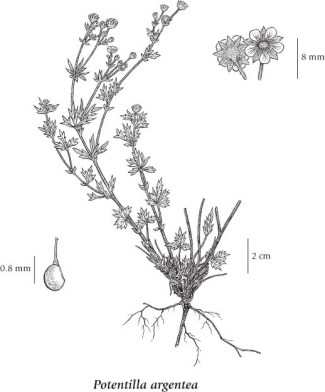Potentilla argentea L.
silvery cinquefoil (silver cinquefoil)
Rosaceae (Rose family)
Introduction to Vascular Plants
silvery cinquefoil (silver cinquefoil)
Rosaceae (Rose family)
Introduction to Vascular Plants
Species Information
General:
Perennial herb from a heavy woody stem-base; stems several, tufted, spreading to erect, 10-50 cm tall, very leafy, freely branched, white-woolly.
Leaves:
Basal leaves few, stalked, palmately compound; leaflets mostly 5, lanceolate, 1-2.5 cm long, deeply toothed to cleft above the middle into narrow teeth with rolled-under margins, greenish and silky-hairy on the upper surface, white-woolly beneath; stem leaves alternate, 5 to 10, similar but short-stalked to unstalked.
Flowers:
Inflorescence an open leafy terminal cluster of many stalked flowers; corollas yellow, bowl-shaped, the petals 5, egg-shaped, 2-4 mm long; calyces silky-hairy, 5-lobed, the lobes lance-egg-shaped, about as long as the petals, alternating with 5 narrower bractlets; ovaries superior, the styles thickened and glandular-warty at the base; stamens about 20.
Fruits:
Achenes, numerous, clustered, lopsided-egg-shaped, about 0.7 mm long, smooth or faintly net-veined. vol_7
Illustration

If more than one illustration is available for a species (e.g., separate illustrations were provided for two subspecies) then links to the separate images will be provided below. Note that individual subspecies or varietal illustrations are not always available.
Illustration Source: The Illustrated Flora of British Columbia
Ecology
Ecological Framework for Potentilla argentea
The table below shows the species-specific information calculated from
original data (BEC database) provided by the BC Ministry of Forests and Range.
(Updated August, 2013)
The table below shows the species-specific information calculated from
original data (BEC database) provided by the BC Ministry of Forests and Range.
(Updated August, 2013)
| Site Information |
Value / Class |
||
|
Avg |
Min |
Max |
|
| Elevation
(metres) |
923 | 0 | 1930 |
| Slope
Gradient (%) |
30 | 0 | 230 |
|
Aspect (degrees) |
208 | 5 | 360 |
| Soil
Moisture Regime (SMR) [0 - very xeric; 4 - mesic; 8 - hydric] |
2 | 0 | 7 |
| Modal
Nutrient Regime
Class |
D | ||
| #
of field plots species was recorded in: |
104 | ||
| Modal
BEC Zone Class |
IDF | ||
|
All BEC Zones (# of stations/zone) species was recorded in |
BG(2), BWBS(4), CWH(1), ESSF(10), ICH(13), IDF(33), MS(6), PP(8), SBPS(2), SBS(19) | ||
|
Source:
Klinkenberg 2013
|
|||